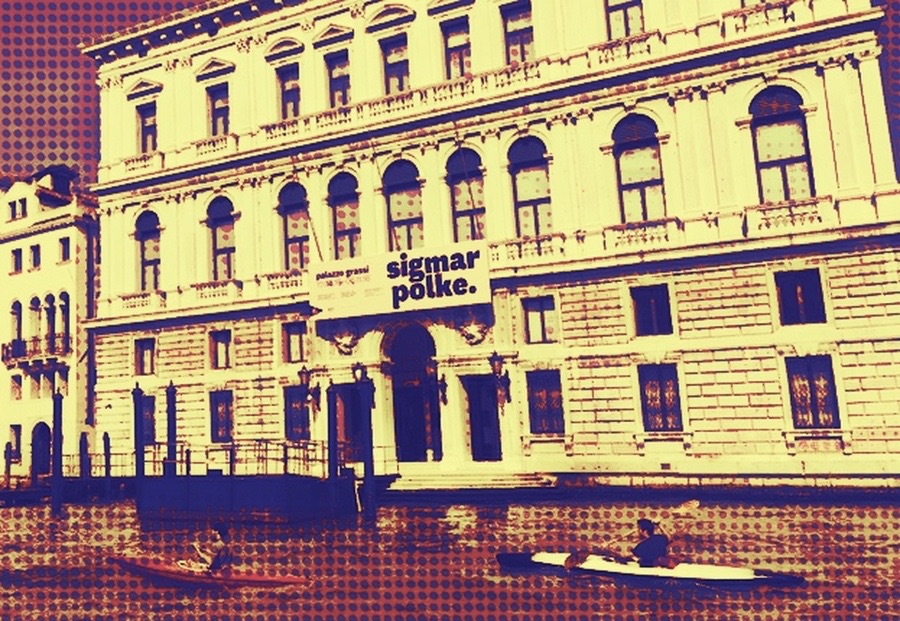
Sigmar Polke, Palazzo Grassi, Venice
12. October 2016(Venice, Italy)
Currently running is the Sigmar Polke retrospective at the Pinault Foundation, Palazzo Grassi, in Venice. This year marks the 75th anniversary of Polke’s birth and the 30th anniversary of his participation in the 1986 Venice Biennale, where he was awarded the Golden Lion.
The German artist Sigmar Polke (1941-2010) fills the entire space of Palazzo Grassi with his mystical, magical art, leaving his fingerprints all over four decades. Through the rooms of the Venetian palace the exhibition follows a reverse chronological order, highlighting the diversity of Polke’s techniques and formats including painting, drawing, installation and film.
The solo exhibition contains nearly 90 works from the Pinault Collection as well as other public and private collections, and traces the German artist’s life and career all the way back to the 60s. It is the first retrospective show in Italy dedicated to the artist who was known for not answering the phone or giving interviews. His obituary in the New York Times (2010) labelled him a “quixotic pop artist who used ordinary materials to create the extraordinary”.
Designed by Elena Geuna and Guy Tosatto, director of the Musée de Grenoble, in close collaboration with the estate of Sigmar Polke, the exhibition showcases the work of an artist who renewed the pictorial language of the end of the last century.
Inside the central spazio of Palazzo Grassi the exhibition opens with Axial Age (2005-2007), a collection of seven monumental paintings by Polke that were originally exhibited in the central pavilion at the 2007 Venice Biennale. The series of works represents the German author’s artistic testament, evoking the interplay between the visible and invisible and the differences between thought and perception; the collection’s name refers to German philosopher Karl Jaspers’ Axial Age theory.
The visit to the Venice exhibition continues on two floors, in backward chronological order through the different studies applied by Polke during his artistic career. Interest in the topic of alchemy of shapes and colours is made explicit by displayed works as Magische Quadrate (1992). The first floor rooms show Polke’s evolution in the last 20 years of his life, with works as Strahlen Sehen (2007) – a series of five works painted in acrylic on polyester that reflect the vision of the stars in the 18th century – and the even more extraordinary Hermes Trismegistus (1995), a work in four parts inspired by the marble inlays on the floor of the cathedral of Siena and the dominating inspiration of alchemy, which Polke interprets through colours related to the alchemical process (black, white, yellow and red). The playful aspect of the German artist’s painting emerges in works where the images are manipulated by the copier and overlapping or fragmented due to the enlargement of photographic texture, as in Man füttert die Hühner (2005).
The retrospective contains a programme of unseen 16mm films, carefully selected by his children Anna and Georg Polke, that shed a new light on the artist’s playful experiments with the moving image in relation to his famous oeuvre. The footage was captured by the artist on his Beaulieu camera. Among the films there is, for example, Ohne Titel (Venice Biennale), in which Polke films visitors of the 1986 Biennale Pavilion and their reactions to his works. Polke’s home movies are combined with footage of his work, the Biennale and everyday life scenes of himself and people around him just playing and goofing around – all contributing to an unexpected intimate insight into Polke the artist.
On the second floor is the poetic Laterna Magica (1988-1992), featuring seven painted scenes on both sides with the theme of an English nursery rhyme of the early 20th century. Next to these paintings are the political images, which Polke made with the Rasterbilder technique used by the artist since the 60s. These feature provocative works such as Polizeischwein (1986) and the condemnatory piece Amerikanisch-Mexikanische Grenze (1984), which portrays the border between Mexico and the United States.
Particularly valuable is the section dedicated to the artist’s beginnings, which also brings together a number of sculptures and installations such as Kartoffelhaus (1967-1990), the home of potatoes that hints to the economic difficulties in post-war Germany.
Conclusion
The journey followed in this exhibition is that of a chameleon. In the end I am impressed by Polke’s visionary quality, his projects and their variety – not to mention his sense of irony. It is hard to believe that the exhibited works are all by the same artist, and this ability to change his approach is also its greatness.
For me, the incredible strength of Polke’s work is his ability to plait stories together while revealing the real plot only to the sort of patient eye that can focus on detail. The same thing is true of Zirkusfiguren (2005). His imposing portrait of a circus world is more than glitter and glamour and the colours of childhood; it contains a tragic and elusive poem, in which the playful appearance reveals an unpredictable subtext – just like in real life.
